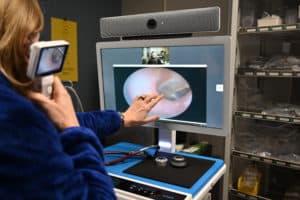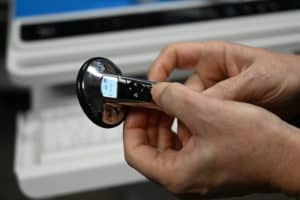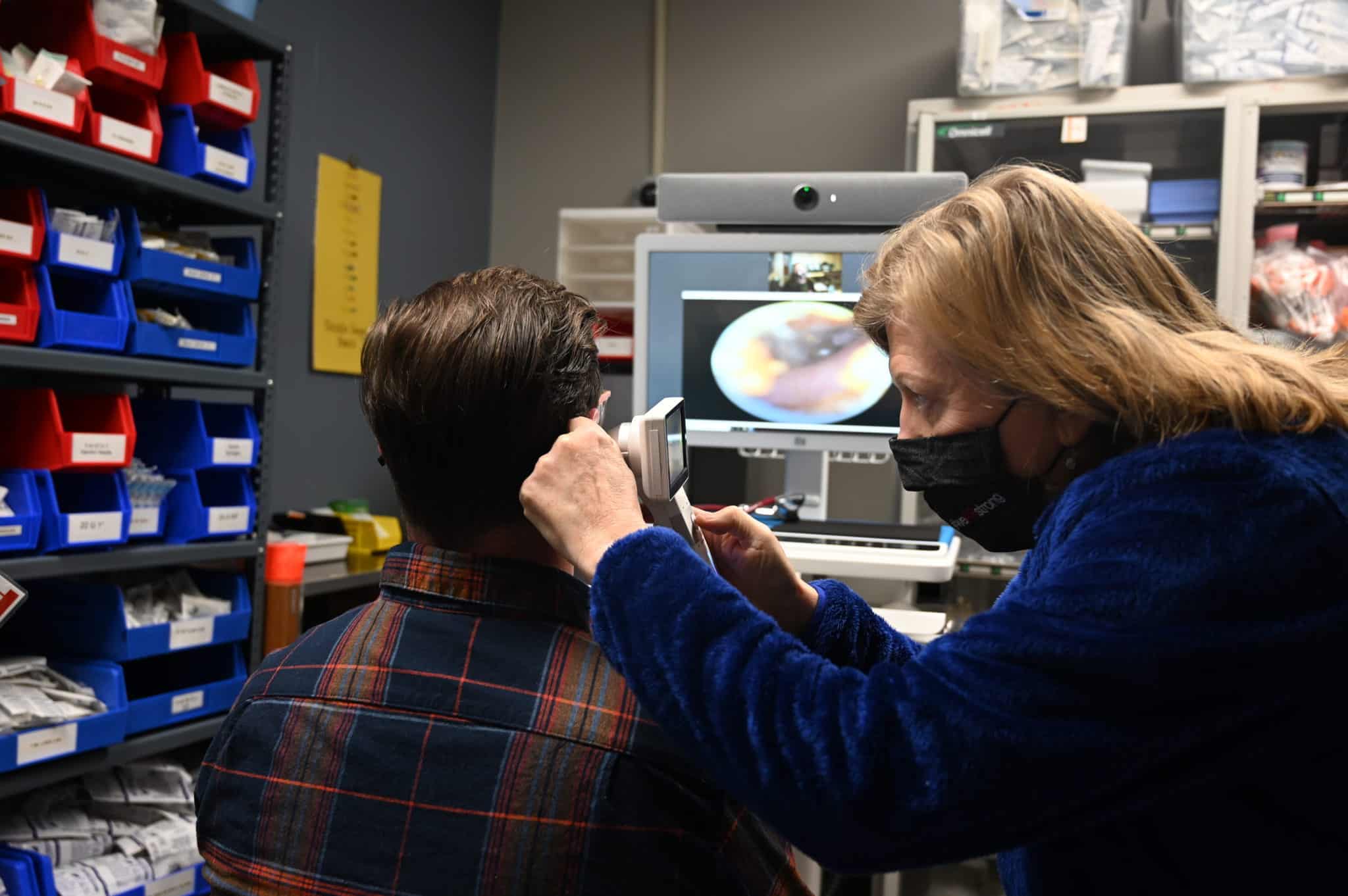Grant Purchase Equips Nursing Students for Future in Digital Health
| This semester, students in both undergraduate and graduate degree programs in the UAMS College of Nursing will be able to experience thorough, hands-on experience with digital health using technology recently purchased with grant funds awarded by the Gertrude E. Skelly Charitable Foundation.
“We want to train students to use devices, such as tablets with peripherals that measure weight, blood pressure or other health measures that can be sent digitally, as well as equipment that receives that information,” said Patricia Cowan, Ph.D., RN, dean of the UAMS College of Nursing and principle investigator on the grant.

De Gravelles projects images of her ear captured by the peripheral scanner and explains how they’d be used in education programs, pointing out specific elements of the image nurses will be trained to look for.Spencer Watson
The equipment, purchased with $24,000 in grant funds, is already being incorporated into course offerings, said Brittany Beasley, Ph.D., RN, a clinical instructor in digital health.
“We are on the cutting edge to be able to provide this training and exposure to students of all levels to learn how to use this equipment,” she said. “It’s another way to deliver high quality care and expand our reach to patients we wouldn’t otherwise be able to see.”
Equipment purchased includes both a cart with peripherals, or accessories, used to simulate patient experiences during training and hub equipment so nurses can be well trained to receive remote information as providers of digital health. Purchases were guided by advice from the UAMS Institute for Digital Health & Innovation to conform to best practices and to buy the same equipment currently used in clinical practice.
“It puts students into a hands-on environment, with hands-on experience, in which they get to work through some of the issues, because it’s a different way of providing care,” said Beasley, who has been in digital health practice for more than 15 years.
“Until you do it, you don’t realize things you might need to consider, even simple things like the volume of your voice, your distance from the camera, and talking to everyone in the room, including those off camera, and making sure they’re allowed to be involved in conversations about the patient’s health.
The coursework also includes education on regulations of digital health practice, such as licensure requirements when treating out-of-state patients.
Because of the COVID-19 pandemic, many regulations on digital health have been temporarily relaxed. But the sudden embrace of these visits, especially with in-person visits posing a risk to patient health, has really paved the way for broader adoption of digital health – and highlighted the need for future providers to be even more comfortable giving care in this context.
“I don’t see going back to the old ways of conducting business,” said Beasley. “I think the relaxed laws with COVID-19 will move forward. There may be some restrictions re-imposed or new consent forms, but certainly nurses will not only have to know it’s an option, but know logistically how it’s used and in what scenarios.”
That future makes the college’s innovations all the more important.

Among the peripherals purchased for training is a digital stethoscope, which wirelessly transmits readings back to nurse’s cart.Spencer Watson
“I am thrilled the College of Nursing Innovative Practice and Simulation Center is able to offer our students this level of training in digital health,” said Pamela de Gravelles, Ph.D., RN, CHSE, clinical assistant professor and IPC/Simulation Coordinator in the college. “Adding state-of-the-art digital health machines and peripherals to our equipment is a major step toward preparing our nurses for caring for all populations in a variety of settings and locations, particularly our rural residents in Arkansas.
“We are leaders in this exciting move toward caring for all Arkansans while meeting our strategic plans for the university and the college,” she added.
This level of instruction sets the UAMS College of Nursing apart in teaching tomorrow’s care today, Beasley said.
“I think it’s amazing we have this equipment to do simulations and practice with. As far as I know, our college is unique in this capacity. Our students now have the advantage of gaining this experience in a simulation environment before having to do it in practice.”
